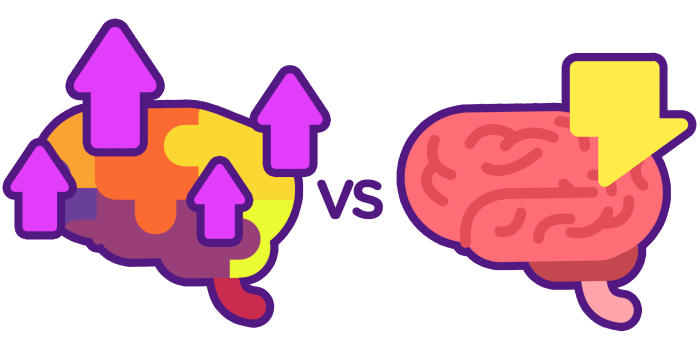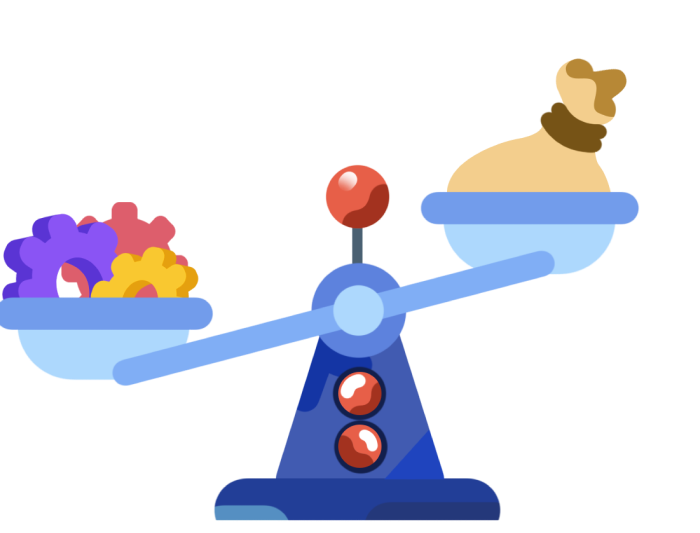Team-level collaboration has already become a staple of the contemporary working experience and, with the advance of technology and the ever-growing wave of remote work, it is bound to take on an even greater significance in years to come.
However, collaboration is not equally suited to every team and every professional scenario. There are a number of professional situations where a collaborative approach may birth more obstacles and challenges and produce lesser results than a different approach to work distribution. Additionally, interpersonal team dynamics and other factors create additional risks for the success of a collaborative relationship.
As we have already written extensively about the benefits of collaboration, we will use the following lines to highlight a number of professional situations in which collaboration promises a significant upside, but also comes with potential downsides. We will examine both sides of the coin in order to compare the risks and potential benefits and try to identify the factors that significantly impact the outcomes.
Collaboration is a form of human interaction. As with any other interaction, its quality and its success are highly predicated on the individual traits of collaborators. Depending on the combination of team members and their individual characteristics (communication skills, interpersonal skills, motivations, etc.), different collaboration scenarios can either provide benefits for the organization or create obstacles and challenges detrimental to its overall operations. Let’s take a look at these scenarios and see how and why they can result in wildly different outcomes.
Role distribution vs. role ambiguity
One of the main desired benefits of collaboration is the optimal distribution of roles across the team. Ideally, individual roles and responsibilities of team members will be distributed in a manner that maximizes their individual skills and combines them for increased efficiency – both in terms of time and output.
In practice, this isn’t necessarily the case. With the dynamic and often fluent nature of the shared work, a collaborative approach can sometimes create ambiguity and uncertainty regarding individual roles and responsibilities, thus significantly hindering the collaborative process. The consequences of this ambiguity can be different: some team members may falsely suppose that the responsibility lies elsewhere, other team members may assume a false role of authority or leadership, while others may begin to feel that not all of their colleagues are contributing equally. Such situations can lead to conflict, apathy, and decreased productivity.
Best practices: Ambiguity and uncertainty regarding team roles can be avoided by clearly defining and communicating roles from the start, increasing the transparency of everyone’s work, as well as clearly defining tasks, deadlines, and expectations, tracking the progress and providing feedback to ensure that everyone’s on the same page and pulling their own weight.
Shared accountability vs. no accountability
In a best-case scenario, collaboration leads to a shared sense of accountability for the success of the process, in which all team members are aware of the importance of their contributions to the outcome of the project and invested in the achievement of team objectives. This leads to a sense of a shared purpose, and, consequently, increased levels of motivation and engagement among team members.
In reality, the shift of responsibility from an individual level onto a team can blur the lines of individual responsibility and make it difficult to recognize individual contributions. This is equally important for positive outcomes where it can be difficult to identify the most impactful contributions (“give credit where credit is due”), as well as negative outcomes where we need to understand what went wrong. The negative scenarios of blurred accountability include team members avoiding their individual responsibilities and “hiding” behind the team, a sense of frustration and demotivation from having one’s work unrecognized or feeling as if others aren’t equally committed, a lack of trust among team members, as well as a decreased ability to properly reward positive contributions and criticize and correct the negative ones.
Best practices: Preventing a lack of accountability on a team begins by properly communicating the team’s vision and objectives, with a full understanding of how individual efforts contribute to their realization. While collaboration is a team effort, all participants must perform their individual tasks, and it is essential that individual work is visible and transparent so that team members could keep each other accountable.
Increased creativity vs. too much brainstorming

One of the greatest benefits of collaboration on multidisciplinary teams is the increased creativity and the capacity for problem-solving arising from different skill sets, perspectives, and professional backgrounds of team members. This professional diversity can spark innovation, increase the team’s ability to find answers for difficult and unforeseen challenges, and improve its flexibility in responding to changing circumstances.
On the flip side, the work can easily become bogged down by time-consuming brainstorming sessions, meetings, and debates, thus slowing down the collaborative process and detracting from regular responsibilities and “actual” work. The process can be further slowed down and complicated through conflicting perspectives and a lack of resolution.
Best practices: Inefficiency caused by excessive brainstorming and discussion can be minimized or avoided by keeping the allotted time under control and setting aside specific time slots for consultation, attempting to achieve the optimal balance between consultations and active work. Additionally, teams can take steps to increase the efficiency of their meetings and brainstorming sessions by narrowing the focus of the sessions and insisting on actionable conclusions.
Balanced decision-making vs. group thinking
Collaborative work often implies a more distributed leadership style and a more inclusive decision-making process. If team members have a say in defining the future course of work, they are bound to be more invested in it and more motivated to achieve the shared goals. The decisions are reached by the consensus of multiple perspectives, thus providing a more comprehensive and better-informed foundation for choosing the best path forward.
The downside of an inclusive decision-making process is that it is greatly shaped by the specific group dynamics present on a team. Consequently, the process can easily slip into less desirable patterns of behavior. Some examples of these patterns are group thinking, where the opinions of other team members are swayed by the influence of more authoritative colleagues and alternative perspectives are rebuffed or ignored, conflicts of diverging opinions where disagreements can not be easily resolved in a positive manner, or indecisiveness that can both waste time and deteriorate team chemistry.
Best practices: A healthy and effective collective-decision making process is predicated on the existence of a safe and inclusive environment that encourages everyone to take part and respects everyone’s input. It is essential that all voices are treated equally. Additionally, teams should institute clear and fair mechanisms for resolving disagreements and making decisions in situations of deadlock, whether through the authority of a team leader, voting, or a different model.
Improved outputs vs. costs of collaboration

Ideally, collaboration combines diverging skill sets in order to produce results greater than the sum of its parts. The multi-disciplinary nature of teams enables them to tackle and overcome challenges that could not be handled by a more narrow and uniform skill set. Additionally, strong interpersonal relationships and a shared vision result in increased motivation and greater productivity.
On the other hand, every collaboration comes with its specific costs expressed in the form of time. From meetings and written communication to additional work and all other aspects of working together, collaboration consumes time that can be spent on independent, autonomous work. If a collaboration hinders the regular work of the participants and impacts their performance, it can slow down the overall operations of an organization.
Best practices: The cost of collaboration should be assessed and compared to other models of work organization before it even commences. Proper and objective assessment of team resources is a critical prerequisite for correctly choosing whether to collaborate or not. The results of collaboration should be regularly monitored and assessed in order to determine its effectiveness and make any necessary adjustments.
Improved morale vs. the potential for conflict
By design, a collaborative environment brings people closer together through a shared vision, shared accountability, and a shared investment in the outcome of the collective work. A harmonious collaboration creates a positive outlook on the team’s work environment, strengthens personal relationships, and breeds trust among team members, which all adds up to increased morale and a stronger sense of belonging.
Alternatively, collaborations carry a risk of conflict among team members, whether through diverging styles of work, unhealthy competition, or simply opposing character traits. There is a big difference, but also a thin line between professional disagreements and personal conflicts, and if the former turn into the latter it can have a truly detrimental impact on team morale and, ultimately, team productivity.
Best practices: Creating a harmonious work environment that positively impacts team morale is not a simple one-track process, but a comprehensive effort that involves virtually all aspects of an organization’s activities. Its primary prerequisite is healthy and open communication that’s respectful of everyone’s unique values and perspectives, a safe environment where opinions can be exchanged freely and constructively. However, conflicts can arise even in the most positive environments, and it is important that they are addressed quickly and properly before they begin to exert a negative influence on the team. Additionally, the compatibility of individual characteristics of team members should be strongly considered when structuring a collaborative team.
Collaboration helps companies triumph — enhance yours with Pumble
In an increasing number of professional scenarios, collaboration has become the preferred, and often necessary model of work organization.
Its practical value, however, can vary depending on the nature of specific work, team and organization as well as the way it’s implemented.
To facilitate effective collaboration in your team and organization — use Pumble.
Pumble is a comprehensive collaboration tool that allows team members to:
- Connect with each other,
- Reduce the number of emails they exchange,
- Save time,
- Increase productivity, and, most importantly,
- Improve their collaboration.
Pumble can be a true game-changer for your company
Comment nous examinons cet article : Nos rédacteurs et éditeurs vérifient les articles et les mettent à jour lorsque de nouvelles informations sont disponibles, afin qu'ils soient toujours d'actualité.

